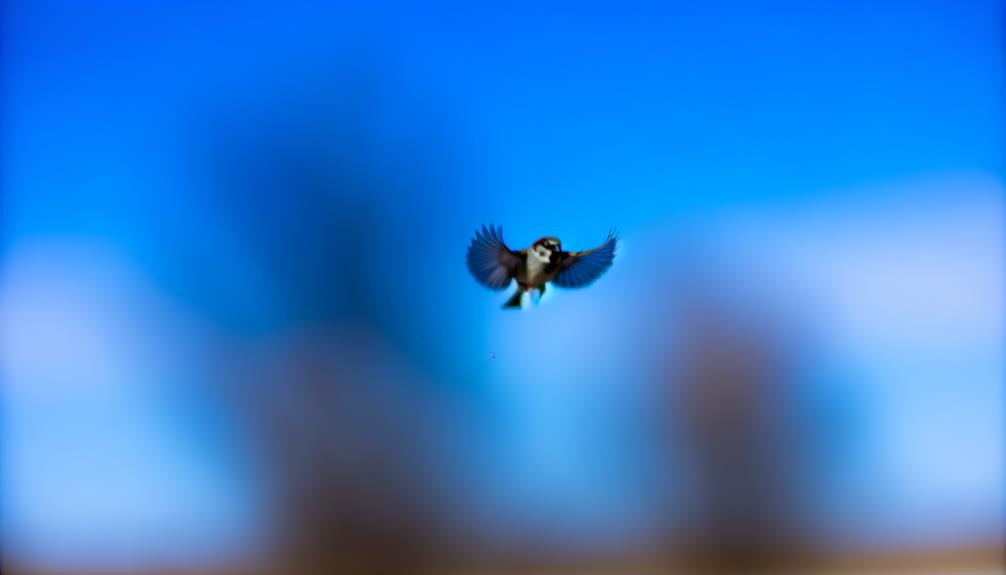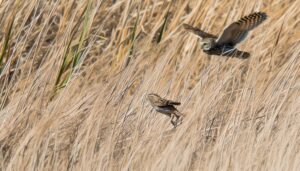How Do You Observe Common House Sparrow Flight Patterns?
The common house sparrow's flight showcases an intriguing mix of energy-efficiency and power. This tiny bird engages its robust pectoral muscles to execute a flap-gliding technique, balancing exertion with conservation.
It navigates using visual landmarks and sensing the Earth's magnetic field. Sparrows adeptly modify their flight strategies as per their environment, using wind currents and adjusting their flight height relative to temperature.
Their urban adaptability speaks to their dietary flexibility and nesting innovation. It's a thrilling world of aerodynamics, wing design, and evolutionary genius that's worth delving into, revealing intricate details of this fascinating species' ability to survive and thrive.

Key Takeaways
- Common House Sparrows use a combination of flapping and gliding techniques for efficient long-distance flight.
- Sparrows' pectoral muscles power their flapping, providing lift and thrust, while gliding conserves energy.
- The sparrows' unique flight patterns include rapid, darting movements to evade predators and high wing-beat frequency for quick speed bursts.
- They adapt to weather conditions, using wind currents for energy conservation and altering flight height with temperature changes.
- Sparrows have evolved to navigate urban environments with structural adaptations for maneuverability and opportunistic behavior for survival.
Understanding Sparrow Flight Mechanics
Delving into the flight mechanics of the common house sparrow, it becomes apparent that these small birds use a combination of flapping and gliding techniques to move efficiently through the air.
The sparrow's flapping motion, primarily powered by the pectoral muscles, provides both lift and thrust, acting as the primary propulsion system. Meanwhile, gliding helps conserve energy, with the bird extending its wings fully, utilizing the air's resistance to maintain altitude without the constant need for flapping.
Understanding this intricate balance between exertion and conservation is essential, as it sheds light on the sparrow's ability to sustain prolonged flights. This analysis, while technical, underscores the marvel of avian mechanics, illustrating nature's own solution to the challenges of flight.
Unique Sparrow Flight Patterns
In the world of avian dynamics, the house sparrow presents an intriguing case study due to its unique flight patterns. A detailed analysis of sparrow aerodynamics and wing design can provide insight into how these birds achieve their distinct flight maneuvers.
Moreover, the impact of the environment on these patterns shouldn't be overlooked, as factors such as wind strength and direction, temperature, and humidity can greatly alter the flight behavior of sparrows.
Understanding Sparrow Aerodynamics
Observing the common house sparrow's flight, we notice distinct aerodynamic patterns that set them apart from other bird species. When a sparrow takes flight, it initially generates powerful thrust with rapid wing beats, allowing it to ascend swiftly.
Once airborne, the sparrow alternates between active flapping and passive gliding, conserving energy while maintaining velocity. This flight pattern, known as 'flap-gliding', is particularly efficient and allows sparrows to travel long distances without tiring.
Sparrows also display remarkable agility in flight, capable of sudden turns, stops, and dives. This aerobatic prowess is due to their small size, light weight, and unique flight dynamics.
Understanding these aerodynamic principles offers insight into the sparrow's survival strategy in diverse environments.
Sparrow Wing Design
The intricacy of a sparrow's wing design plays a pivotal role in its unique flight patterns. Each wing comprises primary, secondary, and tertiary feathers, all arranged in a specific order to maximize lift and reduce drag.
The primary feathers, the longest and most outward ones, provide the thrust needed for takeoff and flight. Secondary feathers, located closer to the body, are designed for lift and balance. Tertiary feathers, the smallest ones, aid in maneuverability.
The sparrow's lightweight skeleton and strong pectoral muscles complement this feather arrangement, enabling the bird to perform intricate aerial acrobatics. Its wing flapping style is rapid and intermittent, facilitating energy conservation during flight.
Hence, the sparrow's wing design is a marvel of natural engineering, contributing significantly to its distinctive flight capabilities.
Impact of Environment
While the design of a sparrow's wings greatly influences its flight patterns, their environment also plays a significant role in shaping these intricate aerial maneuvers.
Variations in wind currents, for example, can alter a sparrow's flight trajectory, compelling it to adjust its wing flapping frequency and amplitude. Similarly, temperature and humidity can affect the bird's flight efficiency. In cooler environments, sparrows may need to expend more energy to maintain body heat, while high humidity can increase air density, making flight more strenuous.
Predators, vegetation, and other environmental factors also impact flight patterns. Sparrows may dart more unpredictably in predator-rich environments, or weave deftly through dense foliage. Consequently, environmental factors profoundly shape the flight dynamics of the common house sparrow.
Sparrow Navigation Strategies
Despite their small size, sparrows employ sophisticated navigation strategies, relying heavily on visual cues and innate abilities to traverse vast distances. These avian explorers exhibit a mastery of navigation that's truly remarkable, given their diminutive stature.
Sparrows employ four key strategies for navigation:
- Visual Landmarks: Sparrows use familiar sights such as trees and buildings to orient themselves during flight.
- Sun Compass: Sparrows can use the sun's position to determine direction, adjusting for time of day.
- Star Patterns: At night, sparrows may use constellations to navigate, much like ancient mariners.
- Geomagnetic Field: Sparrows can sense Earth's magnetic field to maintain their bearings.
These strategies, in their complexity and elegance, reveal the intricate ways nature equips creatures for survival.
Adapting to Urban Environments
The house sparrow's ability to adapt to urban habitats necessitates a detailed analysis of its survival skills within city landscapes.
In considering the ways these small birds have adjusted to human-dominated environments, we must also examine the direct and indirect impacts of human activities on their populations.
Through this, we can gain an understanding of the intricate interplay between these resilient creatures and the increasingly urbanized world they inhabit.
Sparrow's Urban Habitat Adaptations
In adapting to urban environments, house sparrows have showcased remarkable flexibility and innovation. This resilience stems from four key adaptations:
- Structural Adaptation: Sparrows have developed shorter wings and broader bodies, an adaptation favoring maneuverability in tight, urban spaces.
- Dietary Flexibility: They're highly omnivorous, capable of consuming a wide range of urban food sources, from human scraps to insects.
- Nesting Innovation: Sparrows have exploited man-made structures, nesting in crevices of buildings, street lamps, and the like.
- Behavioral Changes: They've become highly social and opportunistic, traits that aid survival in bustling urban landscapes.
These adaptations reflect the sparrow's ability to exploit the opportunities and navigate the challenges of urban living, demonstrating the species' remarkable evolutionary agility.
Survival Skills in Cities
Getting around city life requires sparrows to employ a suite of survival skills that extend beyond their physical adaptations and into the domains of behavior, diet, and habitat selection.
Behaviorally, they've developed unique ways to navigate the urban jungle, such as recognizing traffic patterns to avoid collisions.
Their diet has also evolved, showing a preference for urban food sources like discarded human food and urban insects.
In addition, sparrows have displayed an uncanny ability to select habitats within cities that offer the greatest survival advantage. They tend to choose places near human dwellings, where food and water are plentiful, and predators are less common.
These survival skills underline the sparrow's remarkable adaptability and resilience in urban environments.
Human Impacts on Sparrows
As human populations continue to expand and urbanize, sparrows have shown remarkable adaptability, undergoing significant behavioral and physiological changes to survive in these novel environments.
Sparrows' adaptation can be illustrated through:
- Altered Feeding Habits: Urban sparrows frequently feed on human leftovers, adapting their diet from seeds and insects to whatever is available.
- Shift in Nesting Sites: These birds often nest in man-made structures, showcasing their flexibility.
- Increased Vocalization: Sparrows in cities tend to sing louder and at a higher pitch to overcome the noise pollution.
- Change in Breeding Cycle: Some sparrows have adjusted their breeding season to align with the availability of human-provided food resources.
Hence, human impacts have induced significant adaptations in sparrows, demonstrating their resilience and survival capability.
Sparrow Flight: Evolutionary Aspects
Evolution has remarkably shaped the flight mechanics of the common house sparrow, optimizing it for survival in diverse environments. Over time, these birds have developed a rapid, darting flight pattern that serves to evade predators. Their wings, relatively shorter and rounder compared to other birds, provide superior maneuverability, especially in tight spaces within urban areas.
Evolutionary pressures have also influenced their wing-beat frequency, which is relatively high, enabling quick bursts of speed. Moreover, sparrows have adapted a specific flapping pattern, alternating between flapping and gliding, that conserves energy during flight. This efficient energy usage aids in their survival in environments with varying food availability.
Such evolutionary adaptations underline the sparrow's successful habitation across diverse ecosystems.
Impact of Weather on Sparrow Flight
In the face of varying weather conditions, the flight of the common house sparrow exhibits remarkable adaptability, highlighting the species' resilience and survival tactics. This adaptability is evident in their flight patterns, which are significantly influenced by diverse meteorological elements.
Wind: Sparrows utilize wind currents to minimize energy expenditure during flight, exhibiting an uncanny ability to adjust their wing flapping rate depending on wind strength.
Rain: During rainfall, sparrows typically reduce flight to conserve energy and protect their feathers, which are essential for maintaining body temperature.
Temperature: Sparrows adapt their flight height correlatively with temperature, flying lower in colder weather to avoid chilling breezes.
Sunlight: Direct sunlight affects sparrows' visibility, potentially altering their flight paths and migration patterns.
These adaptations underline the sparrow's inherent survival instincts and resilience.
Conclusion
To sum up, the house sparrow's flight isn't just a bird's journey, but a ballet in the sky, meticulously choreographed by evolution and environmental adaptation.
Their unique flight patterns and navigation strategies showcase a remarkable adaptation to urban landscapes.
Weather plays a significant role, adding a layer of complexity to their flight.
Indeed, each flap of a sparrow's wings unravels a fascinating tale of survival, precision, and dexterity.





